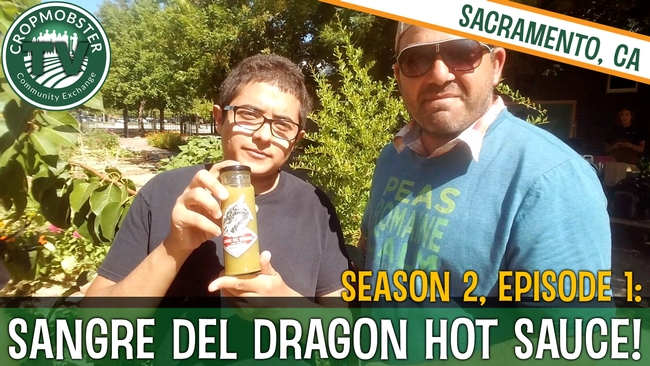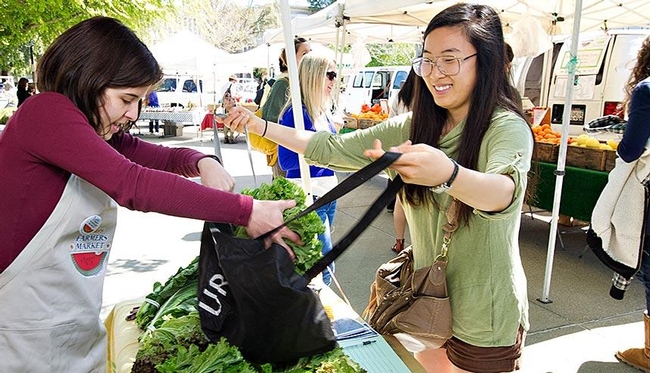- Author: Pamela Kan-Rice
CropMobster TV's Season 2 takes viewers on a journey throug every county of California, meeting food and ag leaders and seeing how they carve out their livelihoods while feeding their communities.
Most consumers' first encounter with their food is in a grocery store or on a plate served in a restaurant, and they give little thought to how the food got there.

As a sponsor of CropMobster TV Season 2, UC Agriculture and Natural Resources is pleased to help introduce some of the Californians who toil behind the scenes to provide consumers the delicious and nutritious food we eat.
Nicky Bobby chats with farmers, people at nonprofit organizations that work to reduce food waste and hunger, scientists, land managers who steward our natural resources and business owners.
“Everybody's into food, but all too often people don't make the connection between food and agriculture,” said Glenda Humiston, University of California vice president for agriculture and natural resources. “When you talk about agriculture, people think of two jobs – farmer and farmworker. There are thousands of jobs in the agricultural ecosystem.
“UC ANR is happy to support CropMobster in telling the stories of the men and women who supply us with safe and abundant food, the challenges that they face and the efforts being made to make the food system even better.”
CropMobster TV is a nonprofit storytelling and video project by CropMobster in collaboration with Food Tank and many other individual and organizational supporters to highlight the crucial work of everyday heroes working to feed their communities.
“Sponsorship and support from UC ANR, which does agricultural research and outreach in every California county, is helping us connect with communities throughout the state,” said Papadopoulos, CropMobster CEO. “We are also grateful for Food Tank and so many other individuals and organizations who are pitching in.”
“This is such a unique, energetic and needed effort to engage our populace on food and agriculture issues,” said Danielle Nierenberg, Food Tank president. “We are thrilled to partner with CropMobster and UC ANR and hope to see the CropMobster vision grow and spread!”
CropMobster TV episodes will be published on:
- CropMobster's Youtube Channel
Episode One: Sangre del Dragón Hot Sauce! (Season 2, Ep 1)
Nicky Bobby attempts to ride Ginger, a horse from Rockney Farms in El Dorado County, then interviews Sacramento high school students at the Alice Waters-inspired Edible Sac High school garden program about their start-up: Sangre del Dragón Hot Sauce company.
To watch and share, https://youtu.be/oyiVQ9AIusM
About CropMobster https://cropmobster.com/
CropMobster partners with bold community leaders to grow high-impact local food networks and community sharing exchanges. The goals are to spark local food economies, engage communities to reduce food waste, support hunger relief and food security efforts and to facilitate sharing of resources.
- Author: Pat Bailey,UC Davis News and Media Relations, (530) 219-9640, pjbailey@ucdavis.edu
Sacramento-area farmers and ranchers who sell their products directly to consumers generate twice as much regional economic impact per dollar of output as do area food producers who don't engage in direct marketing, reports a UC Davis agricultural economist and a team of UC Cooperative Extension researchers.
The newly released study of the four Sacramento region counties of El Dorado, Placer, Sacramento and Yolo found that direct-marketing food producers had a regional output multiplier of 1.86 compared to just 1.42 for producers not involved in direct marketing.
Direct-marketing channels include farmers markets, roadside farm stands and community-supported agriculture programs that provide consumers with regular deliveries of farm products.
“The direct marketers make up a relatively small part of the Sacramento region's agricultural sector, but this study demonstrates that these food producers generate both economic and qualitative benefits for the region,” said study leader Shermain Hardesty, a UC Cooperative Extension specialist in the UC Davis Department of Agricultural and Resource Economics.
“It's important that the economic contributions of direct-marketing farmers and ranchers be taken into consideration so that regional policies can be enhanced to support and nurture the growth of these food producers,” Hardesty said.
The regional economic impacts identified in the study are threefold: revenue received directly by the agricultural producer; a ripple effect when the food producer purchases inputs in the region; and a secondary ripple when the producer and the suppliers of goods and services to the producer, in turn, spend more money in the region on household goods and services.
The report, along with separate economic impact reports specifically for El Dorado, Placer and Yolo counties, is available online.
Sacramento region direct marketers
In the four-county Sacramento region, direct-marketing food producers are a relatively small segment of the total agricultural sector, accounting for 19 percent of the region's farms and only 4 percent of its agricultural production.
The direct-marketing farm operations tend to be smaller and more labor-intensive, and source more of their inputs locally than do nondirect-marketing operations in the area.
The new study was based on economic information gathered from 88 local farmers and ranchers, including 31 vegetable farmers, 48 orchard or vineyard growers and nine livestock producers, each of whom generated at least $1,000 in annual sales from marketing directly to consumers.
After the data were collected, they were incorporated into an economic modeling program to estimate the economic impacts of producers engaged in direct marketing.
Study highlights
Other findings from the report include:
• Sacramento region direct-market producers averaged just $164,631 in one year of sales compared to $568,105 for those not engaged in direct marketing.
• Seventy-three percent of the direct marketers also sold through wholesale channels.
• Overall, the direct-market producers generated 44 percent of their total revenues through direct-marketing channels, 55 percent through wholesale channels and 1 percent through commodity markets.
• For every $1 million of output, the direct-market producers generated a total of 31.8 jobs in the Sacramento region while the nondirect-market producers generated only 10.5 jobs.
• Direct marketers purchased 89 percent of their inputs within the region while the nondirect-market producers purchased 45 percent of their inputs in the region. This local sourcing of inputs was the primary factor responsible for the direct-market producers having a greater economic impact on the region than nondirect-market producers.
Collaborators and funding
Hardesty collaborated on the study with Libby Christensen, Erin McGuire and Gail Feenstra, all of UC Davis; and Chuck Ingels, Jim Muck, Julia Boorinakis-Harper, Cindy Fake and Scott Oneto, all with the UC Cooperative Extension.
Funding for the study was provided by the University of California Division of Agriculture and Natural Resources Competitive Grants Program.





